Now Available on Whatsapp:
+1 (888) 687-4420
Online 24/7
- College Essay
- Argumentative Essay
- Expository Essay
- Narrative Essay
- Descriptive Essay
- Scholarship Essay
- Admission Essay
- Reflective Essay
- Nursing Essay
- Economics Essay
Assignments
- Term Papers
- Research Papers
- Case Studies
- Dissertation
- Presentation
- Editing Help
- Cheap Essay Writing
- How to Order
Speech Writing

The 10 Key Steps for Perfect Speech Writing
16 min read

People also read
Understanding Speech Format - Simple Steps for Outlining
How to Start A Speech - 13 Interesting Ideas & Examples
20+ Outstanding Speech Examples for Your Help
Common Types of Speeches that Every Speechwriter Should Know
Good Impromptu Speech Topics for Students
Entertaining Speech Topics for Your Next Debate
Understanding Special Occasion Speech: Types, Steps, Examples and Tips
Introduction Speech- Tips & Examples
How to Write A Good Acceptance Speech?
Writing A Presentation Speech In English: Tips And Examples
Commemorative Speech - Writing Guide, Outline & Examples
Farewell Speech | Writing Tips & Examples
How to Write an Extemporaneous Speech? A Step-by-Step Guide
A Graduation Speech Writing Guide with Examples
Writing a good speech is tough. Many get stuck not knowing how to organize their thoughts, leading to boring speeches.
Our guide breaks it down step by step, so you can write speeches that really connect. Plus, we’ve added some topics, examples, and tips to inspire you and give you a kickstart.
So, let’s start with the basics!
- 1. What is Speech Writing?
- 2. Elements of Good Speech Writing
- 3. How to Write a Speech?
- 4. Speech Writing Format
- 5. Types Of Speech Writing
- 6. Speech Writing Topics
- 7. Speech Writing Examples
- 8. Speech Writing Tips
What is Speech Writing?
A speech is a verbal presentation given to an audience as a means to express ideas, share information, or persuade others. A speech can serve various purposes such as informing, persuading, entertaining, or inspiring the listeners.
Speech writing is the process of creating a clear and organized script for a spoken presentation. This involves planning the content, choosing the right tone, and structuring the speech so the message is communicated clearly to the audience.
Speech writers carefully choose words , phrases , and rhetorical devices to maximize the impact of the spoken words. They aim to engage, inform, persuade, or inspire the listeners. Good speech writing is a skill that requires careful planning, research, and attention to detail.
Elements of Good Speech Writing
Writing a great speech is all about getting a few things right. Let's break down what makes a speech really work:
- Clear and to the Point: Make sure your message is crystal clear and focused. Know what you want to say and stick to it.
- Know Your Audience: Understand who you're talking to. What do they care about? What do they already know? Customize your speech to fit their interests and level of understanding.
- Start Strong: Grab your audience's attention from the get-go. Use a catchy opening line or an interesting fact to hook them in right away.
- Keep it Organized: A good speech flows smoothly from one point to the next. Divide it into sections—beginning, middle, and end—and make sure each part connects logically to the next.
- Stay on Topic: Don't overload your speech with too much information. Stick to your main message and use examples that support it.
- End Strong: Finish your speech with a bang. Summarize your main points and leave your audience with something to think about or act on.
- Practice Makes Perfect: Rehearse your speech until you're confident. Pay attention to your pace, tone, and body language to make sure you're delivering your message effectively.
Now that you know what elements make a good speech, let’s look into the steps to write one.
How to Write a Speech?
Writing a good speech that engages your audience requires careful planning and execution.
Whether you're preparing a persuasive presentation or an informative talk the following ten steps will guide you from the initial concept to the final delivery:
Step 1: Define Your Purpose and Audience
Begin by identifying the main objective of your speech. Are you looking to inform, persuade, entertain, or inspire your audience? Understanding your purpose will shape the tone, content, and structure of your speech.
Know your audience's demographics, interests, and expectations. Consider factors such as age, education, beliefs, and cultural background. Tailor your speech to resonate with your specific audience.
Step 2: Choose a Topic
Select a topic that aligns with your purpose and audience's interest . Ensure your topic is not too broad or too narrow. You should be able to cover it effectively within your allotted time.
Step 3: Research and Gather Information
Thoroughly research your chosen topic . Utilize reputable sources such as books, articles, academic journals, and trusted websites.
Take detailed notes during your research to have a wealth of information and supporting evidence for your speech.
Step 4: Create a Strong Thesis or Central Message
Your thesis statement is the core message of your speech. It should be clear, concise, and specific. It encapsulates the key idea you want to convey to your audience. This statement will guide the content and structure of your speech.
Step 5: Develop an Outline
Divide your speech into three main sections: Introduction, Body, and Conclusion . Each section serves a distinct purpose.
Outline the main points you want to cover within the body of the speech. Organize them logically, and ensure each point supports your thesis.
Step 6: Write the Introduction
Craft a compelling introduction that captures your audience's attention . Use a hook, such as a relevant quote, story, or question, to pique their interest.
Provide context to help your audience understand the topic, and introduce your thesis statement to set the direction for your speech.
Step 7: Build the Body
In this section, expand on the main points outlined earlier. Each main point should be a clear and distinct idea.
Support your points with evidence, examples, and data. Use transitions to guide your audience smoothly from one point to the next, creating a coherent flow.
Step 8: Craft a Memorable Conclusion
Summarize the key points you've made in the body of your speech. Reiterate your thesis statement to reinforce your central message .
End with a compelling closing statement that leaves a lasting impression on your audience. This can be a call to action, a thought-provoking statement, or a memorable quote.
Step 9: Edit and Revise
Review your speech for clarity , grammar , and coherence . Check for any inconsistencies or unclear language and make the necessary changes.
Step 10: Practice and Rehearse
Practice your speech multiple times to become familiar with the content and the order of your points.
Work on your delivery skills , including tone, pace, and body language. Practicing in front of a mirror or recording yourself can help you identify areas for improvement.
Bonus Step: Get Feedback
If possible, conduct a practice run in front of a small audience. This can be friends, family, or classmates.
Listen to their feedback and address any concerns or suggestions. Incorporating feedback can significantly enhance your speech.
Speech Writing Format
Creating an impactful speech requires following a structured speech format to ensure that your message is conveyed clearly and engages your audience.
Here is a standard speech writing pattern to guide you through the process:
1. Introduction:
- Hook: Start the speech with a compelling hook, such as a question, quote, anecdote, or startling fact, to grab the audience's attention.
- Provide Context: Give your audience a brief overview of the topic and its relevance.
- Thesis Statement: Present your central message or thesis statement, which sets the direction for the speech.
- Main Points: Divide the body of your speech into two to five main points or sections, each supporting your thesis statement.
- Supporting Evidence: For each main point, provide supporting evidence, data, examples, or anecdotes to make your argument compelling.
- Transitions: Use clear transitions between points to maintain a smooth and coherent flow throughout the speech.
3. Conclusion:
- Summarize Key Points: Briefly recap the main points you've covered in the body of your speech.
- Restate Thesis: Rewrite your thesis statement to reinforce your central message.
- Closing Statement: End with a memorable closing statement that leaves a lasting impression, which can be a call to action, a thought-provoking idea, or a final quote.
To get started, you can check out this speech writing template:
Learn more about speech format in this insightful read to get a better understanding!
Types Of Speech Writing
There are many types of speeches , and they are combined into different categories. We will take a look at some basic types of speech writing:
Informative Speeches
Persuasive speeches, entertaining speeches, motivational speeches, special occasion speeches.
Now, let's explore each type in more detail:
An informative speech aims to educate or provide information to the audience. These speeches typically focus on facts, data, and explanations.
Examples: Informative speeches can cover a wide range of topics, such as scientific discoveries, historical events, technological advancements, or explanations of complex concepts.
A persuasive speech aims to convince the audience to adopt a particular viewpoint or take a specific action. These speeches often employ persuasive techniques and emotional appeals.
Examples: Persuasive speeches can address issues like climate change, social justice, political candidates, or consumer choices, urging the audience to support a particular stance or take action.
Entertaining speeches are designed to amuse and entertain the audience. They often include humor, anecdotes, and storytelling.
Examples: Stand-up comedy routines, humorous storytelling, and funny anecdotes are examples of entertaining speeches.
Motivational speeches are meant to motivate and uplift the audience. They often incorporate personal stories, motivational quotes, and themes of resilience and hope.
Examples: Speeches by notable figures like Martin Luther King Jr.'s "I Have a Dream" address social change. Others like commencement speeches inspire graduates to embrace the future.
Special occasion speeches are delivered during specific events or celebrations. These speeches can include toasts, eulogies, wedding speeches, and more.
Examples: A eulogy at a funeral, a wedding toast, or a commencement address at a graduation ceremony are all examples of special occasion speeches.
Speech Writing Topics
The topic is the first and foremost thing that you need to write a speech. Here are some amazing speech-writing topic ideas to help you get started.
Persuasive Speech Topics
- The impact of climate change on our future
- Social media and mental health: is it time for regulation?
- The importance of vaccination in preventing disease outbreaks
- The ethics of artificial intelligence and privacy
- The benefits of renewable energy for a sustainable future
Find more persuasive speech topics in our extensive list.
Demonstration Speech Topics
- How to create a delicious and healthy smoothie bowl
- DIY home renovation: painting techniques and tips
- The art of crafting homemade natural soap
- Mastering Yoga: a guided sun salutation sequence
- Gardening for beginners: planting your first vegetable garden
Impromptu Speech Topics
- If I could travel anywhere in the world right now, I would go to...
- The most influential person in my life and why.
- What superpower I wish I had and how I'd use it.
- A book that changed my perspective on life.
- The best piece of advice I've ever received and how it impacted me.
For more inspiring topics check out our impromptu speech topics blog!
Entertaining Speech Topics
- The art of dad jokes: Making people laugh with cheesy humor.
- Embarrassing moments at family gatherings: A humorous take.
- Hilarious autocorrect fails in text messaging.
- The funny side of pets and their quirky behaviors.
- Epic food mishaps in the kitchen: Tales of culinary disasters.
Check out our blog for more entertaining speech topics !
Informative Speech Topics
- The science behind Covid-19 vaccines
- Exploring the history and impact of the internet
- The art of sustainable gardening and urban farming
- Understanding cryptocurrency and blockchain technology
- The wonders of space exploration: mars missions and beyond
Find more interesting topics for informative speeches to get inspired.
Motivational Speech Topics
- “I’m proud of you my son” someday, my dad will say this to me
- Positive thinking boosts your self-confidence.
- It is perfectly fine for a boy to cry.
- Same-sex couples should be allowed to adopt a child
- I will make my parents proud
Looking for more inspirational speech topics? Read our motivational speech topics blog to get inspired!
Speech Writing Examples
When it comes to learning the art of speech writing practical guidance is important. To show effective speech writing techniques and structure, here are some short speech writing examples for students.
These speech writing samples will help you understand how to craft compelling speeches that resonate with your audience.
Example#2
Here is another example of speech writing class 11:
For additional samples, read through our speech examples blog!
Speech Writing Tips
Follow these tips for writing a speech that not only informs but also inspires and persuades.
- Audience Analysis: Before you start, conduct a thorough audience analysis. Understand their interests, knowledge, and expectations.
- Engaging Speech: Craft an engaging speech that captures your audience's attention from the start. Use rhetorical questions or captivating anecdotes.
- Short Sentences: Keep your sentences concise and easy to follow. Short sentences are more impactful.
- Connect with the Audience: Make your audience feel involved. Use relatable examples and stories to establish a connection.
- Great Speech Structure: Organize your speech with a clear structure, including an introduction, body, and conclusion.
- Rhetorical Questions: Utilize rhetorical questions to stimulate thought and engagement.
- Memorable Sentence Structures: Create memorable sentence structures that stick in their memory and the audience remembers the key message.
- Public Speaking: Remember that public speaking requires practice, so rehearse your speech multiple times to boost confidence and delivery.
Moving towards the end , for effective communication, speech writing is a skill that can empower you to inform, persuade, and inspire your audience. This comprehensive guide has walked you through the essential steps, outlines, and examples to help you craft a compelling and memorable speech.
If you think you are good at speaking but not so good at writing and this thing bothers you a lot, then there is no harm in getting some help. We at MyPerfectWords.com can save you from embarrassment by helping you write an outstanding speech.
With our custom essay writing help, you'll buy speech that not only communicates your message effectively but also grabs your audience's attention.
So request ' just do my essay ' today and get solution to all your writing worries!
Frequently Asked Questions
What is a good sentence starter for a speech.
In speech writing starting lines play a crucial role. You can start your speech with the following:
- Thought provoking question: "Have you ever wondered what it takes to change the world?"
- A powerful quote: "As Nelson Mandela once said, 'It always seems impossible until it's done.'"
- A surprising fact: "Did you know that every minute, over 500 hours of video are uploaded to YouTube?"
- An engaging story: "Let me tell you about a young girl who defied all odds to achieve her dreams."
What are the 10 principles of speech writing?
- Clarity: Make sure your message is clear and easily understandable.
- Purpose: Define the main objective of your speech and stick to it.
- Audience Awareness: Understand your audience's demographics, interests, and expectations.
- Structure: Organize your speech into introduction, body, and conclusion.
- Content Relevance: Choose topics and information that are relevant and meaningful to your audience.
- Engagement: Use storytelling, humor, and rhetorical devices to keep your audience interested.
- Authenticity: Speak sincerely to establish trust and connection with your audience.
- Language: Use simple and concise language appropriate for your audience.
- Impact: Deliver a memorable message that leaves a lasting impression.
- Practice: Rehearse your speech multiple times for smooth delivery and confidence.

Write Essay Within 60 Seconds!

Dr. Barbara is a highly experienced writer and author who holds a Ph.D. degree in public health from an Ivy League school. She has worked in the medical field for many years, conducting extensive research on various health topics. Her writing has been featured in several top-tier publications.
Struggling With Your Paper?
Get a custom paper written at
With a FREE Turnitin report, and a 100% money-back guarantee
LIMITED TIME ONLY!
Keep reading
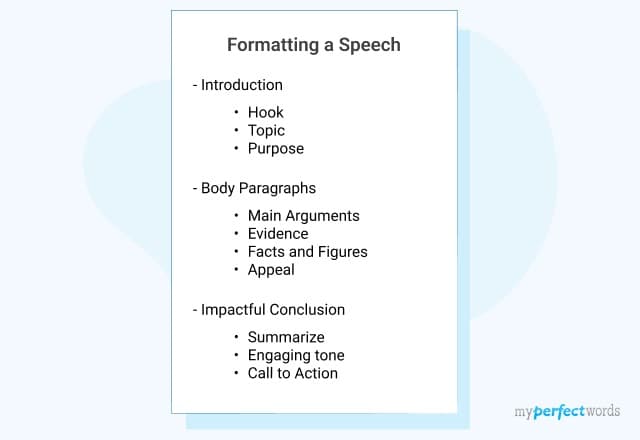
OFFER EXPIRES SOON!
- Games, topic printables & more
- The 4 main speech types
- Example speeches
- Commemorative
- Declamation
- Demonstration
- Informative
- Introduction
- Student Council
- Speech topics
- Poems to read aloud
- How to write a speech
- Using props/visual aids
- Acute anxiety help
- Breathing exercises
- Letting go - free e-course
- Using self-hypnosis
- Delivery overview
- 4 modes of delivery
- How to make cue cards
- How to read a speech
- 9 vocal aspects
- Vocal variety
- Diction/articulation
- Pronunciation
- Speaking rate
- How to use pauses
- Eye contact
- Body language
- Voice image
- Voice health
- Public speaking activities and games
- Blogging Aloud
- About me/contact
How to write a good speech in 7 steps
By: Susan Dugdale
- an easily followed format for writing a great speech
Did you know writing a speech doesn't have be an anxious, nail biting experience?
Unsure? Don't be.
You may have lived with the idea you were never good with words for a long time. Or perhaps giving speeches at school brought you out in cold sweats.
However learning how to write a speech is relatively straight forward when you learn to write out loud.
And that's the journey I am offering to take you on: step by step.
To learn quickly, go slow
Take all the time you need. This speech writing format has 7 steps, each building on the next.
Walk, rather than run, your way through all of them. Don't be tempted to rush. Familiarize yourself with the ideas. Try them out.
I know there are well-advertised short cuts and promises of 'write a speech in 5 minutes'. However in reality they only truly work for somebody who already has the basic foundations of speech writing in place.
The foundation of good speech writing
These steps are the backbone of sound speech preparation. Learn and follow them well at the outset and yes, given more experience and practice you could probably flick something together quickly. Like any skill, the more it's used, the easier it gets.
In the meantime...
Step 1: Begin with a speech overview or outline
Are you in a hurry? Without time to read a whole page? Grab ... The Quick How to Write a Speech Checklist And come back to get the details later.
- WHO you are writing your speech for (your target audience)
- WHY you are preparing this speech. What's the main purpose of your speech? Is it to inform or tell your audience about something? To teach them a new skill or demonstrate something? To persuade or to entertain? (See 4 types of speeches: informative, demonstrative, persuasive and special occasion or entertaining for more.) What do you want them to think, feel or do as a result of listening the speech?
- WHAT your speech is going to be about (its topic) - You'll want to have thought through your main points and have ranked them in order of importance. And have sorted the supporting research you need to make those points effectively.
- HOW much time you have for your speech eg. 3 minutes, 5 minutes... The amount of time you've been allocated dictates how much content you need. If you're unsure check this page: how many words per minute in a speech: a quick reference guide . You'll find estimates of the number of words required for 1 - 10 minute speeches by slow, medium and fast talkers.
Use an outline
The best way to make sure you deliver an effective speech is to start by carefully completing a speech outline covering the essentials: WHO, WHY, WHAT and HOW.
Beginning to write without thinking your speech through is a bit like heading off on a journey not knowing why you're traveling or where you're going to end up. You can find yourself lost in a deep, dark, murky muddle of ideas very quickly!
Pulling together a speech overview or outline is a much safer option. It's the map you'll follow to get where you want to go.

Get a blank speech outline template to complete
Click the link to find out a whole lot more about preparing a speech outline . ☺ You'll also find a free printable blank speech outline template. I recommend using it!
Understanding speech construction
Before you begin to write, using your completed outline as a guide, let's briefly look at what you're aiming to prepare.
- an opening or introduction
- the body where the bulk of the information is given
- and an ending (or summary).
Imagine your speech as a sandwich
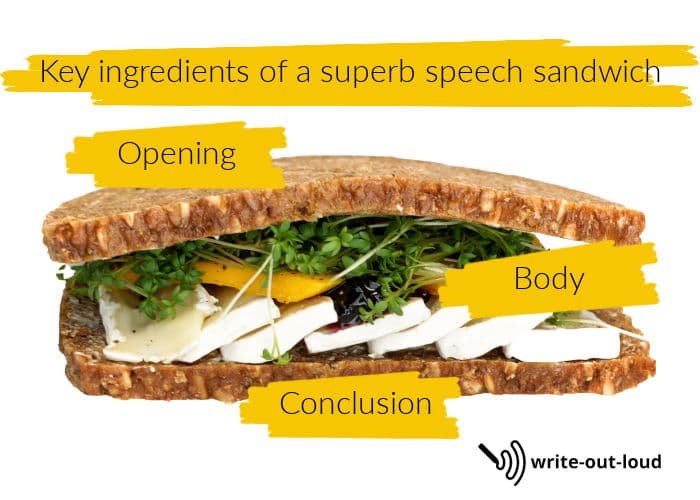
If you think of a speech as a sandwich you'll get the idea.
The opening and ending are the slices of bread holding the filling (the major points or the body of your speech) together.
You can build yourself a simple sandwich with one filling (one big idea) or you could go gourmet and add up to three or, even five. The choice is yours.
But whatever you choose to serve, as a good cook, you need to consider who is going to eat it! And that's your audience.
So let's find out who they are before we do anything else.
Step 2: Know who you are talking to
Understanding your audience.
Did you know a good speech is never written from the speaker's point of view? ( If you need to know more about why check out this page on building rapport .)
Begin with the most important idea/point on your outline.
Consider HOW you can explain (show, tell) that to your audience in the most effective way for them to easily understand it.
Writing from the audience's point of view

To help you write from an audience point of view, it's a good idea to identify either a real person or the type of person who is most likely to be listening to you.
Make sure you select someone who represents the "majority" of the people who will be in your audience. That is they are neither struggling to comprehend you at the bottom of your scale or light-years ahead at the top.
Now imagine they are sitting next to you eagerly waiting to hear what you're going to say. Give them a name, for example, Joe, to help make them real.
Ask yourself
- How do I need to tailor my information to meet Joe's needs? For example, do you tell personal stories to illustrate your main points? Absolutely! Yes. This is a very powerful technique. (Click storytelling in speeches to find out more.)
- What type or level of language is right for Joe as well as my topic? For example, if I use jargon (activity, industry or profession specific vocabulary) will it be understood?
Step 3: Writing as you speak
Writing oral language.
Write down what you want to say about your first main point as if you were talking directly to Joe.
If it helps, say it all out loud before you write it down and/or record it.
Use the information below as a guide
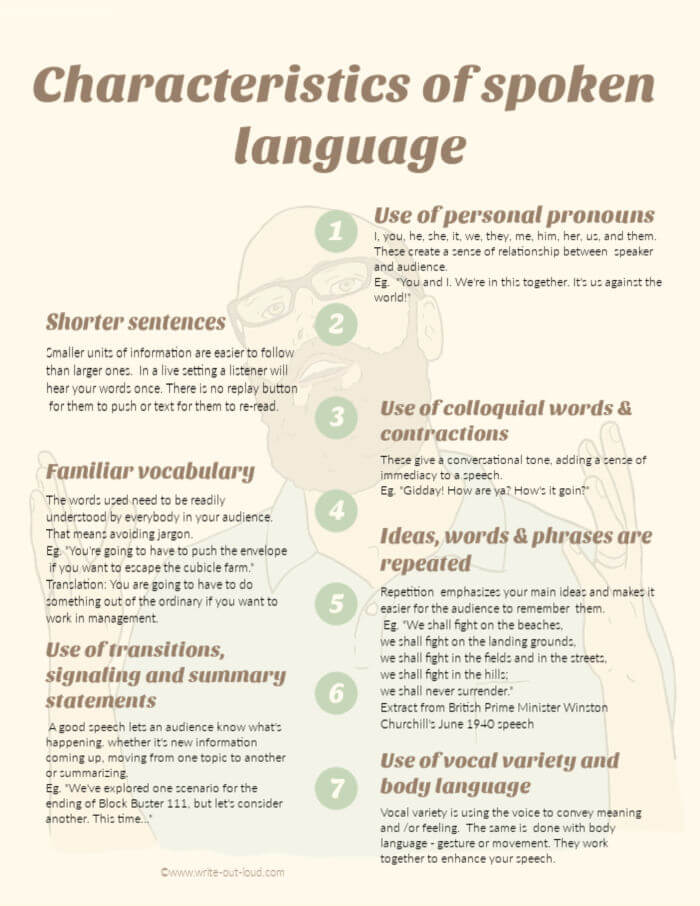
(Click to download The Characteristics of Spoken Language as a pdf.)
You do not have to write absolutely everything you're going to say down * but you do need to write down, or outline, the sequence of ideas to ensure they are logical and easily followed.
Remember too, to explain or illustrate your point with examples from your research.
( * Tip: If this is your first speech the safety net of having everything written down could be just what you need. It's easier to recover from a patch of jitters when you have a word by word manuscript than if you have either none, or a bare outline. Your call!)
Step 4: Checking tone and language
The focus of this step is re-working what you've done in Step 2 and 3.
You identified who you were talking to (Step 2) and in Step 3, wrote up your first main point. Is it right? Have you made yourself clear? Check it.
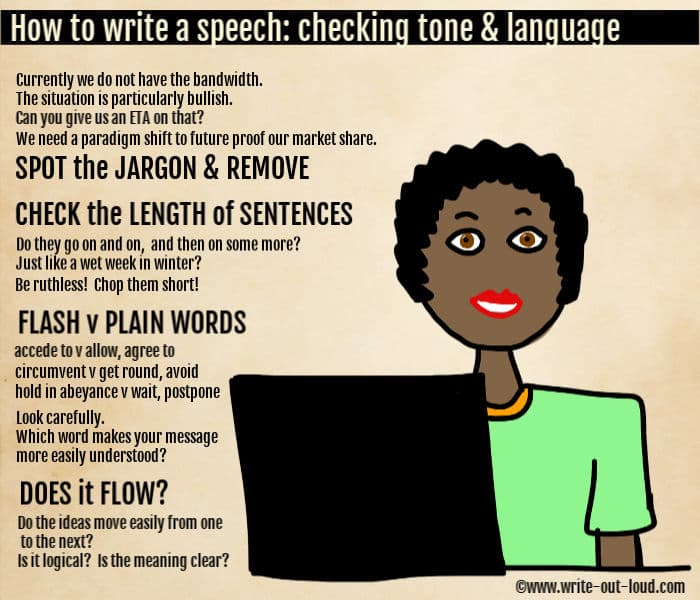
How well you complete this step depends on how well you understand the needs of the people who are going to listen to your speech.
Please do not assume because you know what you're talking about the person (Joe) you've chosen to represent your audience will too. Joe is not a mind-reader!
How to check what you've prepared
- Check the "tone" of your language . Is it right for the occasion, subject matter and your audience?
- Check the length of your sentences. You need short sentences. If they're too long or complicated you risk losing your listeners.
Check for jargon too. These are industry, activity or group exclusive words.
For instance take the phrase: authentic learning . This comes from teaching and refers to connecting lessons to the daily life of students. Authentic learning is learning that is relevant and meaningful for students. If you're not a teacher you may not understand the phrase.
The use of any vocabulary requiring insider knowledge needs to be thought through from the audience perspective. Jargon can close people out.
- Read what you've written out loud. If it flows naturally, in a logical manner, continue the process with your next main idea. If it doesn't, rework.
We use whole sentences and part ones, and we mix them up with asides or appeals e.g. "Did you get that? Of course you did. Right...Let's move it along. I was saying ..."
Click for more about the differences between spoken and written language .
And now repeat the process
Repeat this process for the remainder of your main ideas.
Because you've done the first one carefully, the rest should follow fairly easily.
Step 5: Use transitions
Providing links or transitions between main ideas.
Between each of your main ideas you need to provide a bridge or pathway for your audience. The clearer the pathway or bridge, the easier it is for them to make the transition from one idea to the next.
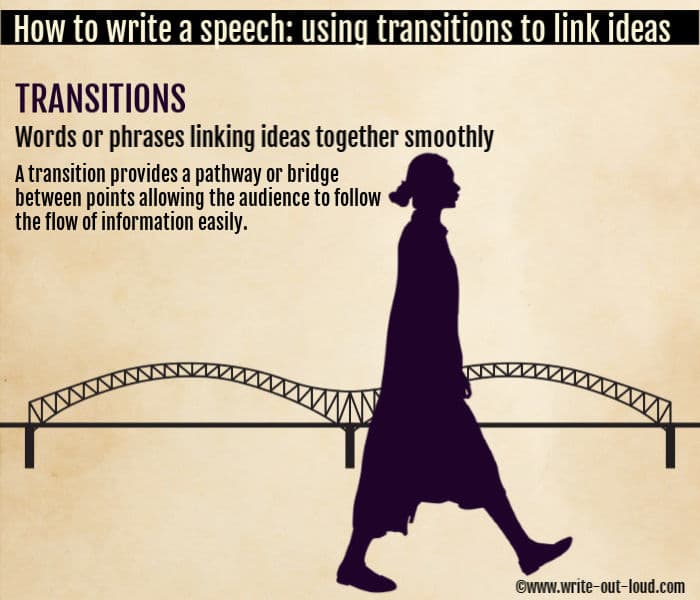
If your speech contains more than three main ideas and each is building on the last, then consider using a "catch-up" or summary as part of your transitions.
Is your speech being evaluated? Find out exactly what aspects you're being assessed on using this standard speech evaluation form
Link/transition examples
A link can be as simple as:
"We've explored one scenario for the ending of Block Buster 111, but let's consider another. This time..."
What follows this transition is the introduction of Main Idea Two.
Here's a summarizing link/transition example:
"We've ended Blockbuster 111 four ways so far. In the first, everybody died. In the second, everybody died BUT their ghosts remained to haunt the area. In the third, one villain died. His partner reformed and after a fight-out with the hero, they both strode off into the sunset, friends forever. In the fourth, the hero dies in a major battle but is reborn sometime in the future.
And now what about one more? What if nobody died? The fifth possibility..."
Go back through your main ideas checking the links. Remember Joe as you go. Try each transition or link out loud and really listen to yourself. Is it obvious? Easily followed?
Keep them if they are clear and concise.
For more about transitions (with examples) see Andrew Dlugan's excellent article, Speech Transitions: Magical words and Phrases .
Step 6: The end of your speech
The ideal ending is highly memorable . You want it to live on in the minds of your listeners long after your speech is finished. Often it combines a call to action with a summary of major points.

Example speech endings
Example 1: The desired outcome of a speech persuading people to vote for you in an upcoming election is that they get out there on voting day and do so. You can help that outcome along by calling them to register their support by signing a prepared pledge statement as they leave.
"We're agreed we want change. You can help us give it to you by signing this pledge statement as you leave. Be part of the change you want to see!
Example 2: The desired outcome is increased sales figures. The call to action is made urgent with the introduction of time specific incentives.
"You have three weeks from the time you leave this hall to make that dream family holiday in New Zealand yours. Can you do it? Will you do it? The kids will love it. Your wife will love it. Do it now!"
How to figure out the right call to action
A clue for working out what the most appropriate call to action might be, is to go back to your original purpose for giving the speech.
- Was it to motivate or inspire?
- Was it to persuade to a particular point of view?
- Was it to share specialist information?
- Was it to celebrate a person, a place, time or event?
Ask yourself what you want people to do as a result of having listened to your speech.
For more about ending speeches
Visit this page for more about how to end a speech effectively . You'll find two additional types of speech endings with examples.
Write and test
Write your ending and test it out loud. Try it out on a friend, or two. Is it good? Does it work?
Step 7: The introduction
Once you've got the filling (main ideas) the linking and the ending in place, it's time to focus on the introduction.
The introduction comes last as it's the most important part of your speech. This is the bit that either has people sitting up alert or slumped and waiting for you to end. It's the tone setter!
What makes a great speech opening?
Ideally you want an opening that makes listening to you the only thing the 'Joes' in the audience want to do.
You want them to forget they're hungry or that their chair is hard or that their bills need paying.
The way to do that is to capture their interest straight away. You do this with a "hook".
Hooks to catch your audience's attention
Hooks come in as many forms as there are speeches and audiences. Your task is work out what specific hook is needed to catch your audience.
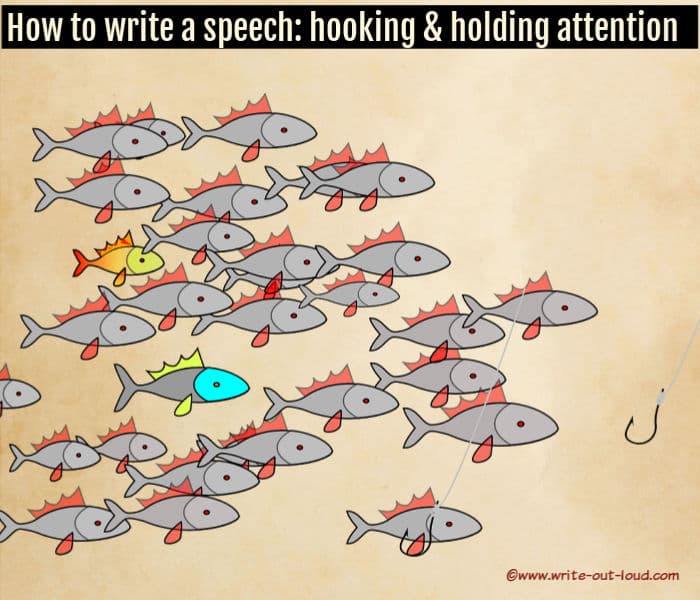
Go back to the purpose. Why are you giving this speech?
Once you have your answer, consider your call to action. What do you want the audience to do, and, or take away, as a result of listening to you?
Next think about the imaginary or real person you wrote for when you were focusing on your main ideas.
Choosing the best hook
- Is it humor?
- Would shock tactics work?
- Is it a rhetorical question?
- Is it formality or informality?
- Is it an outline or overview of what you're going to cover, including the call to action?
- Or is it a mix of all these elements?
A hook example
Here's an example from a fictional political speech. The speaker is lobbying for votes. His audience are predominately workers whose future's are not secure.
"How's your imagination this morning? Good? (Pause for response from audience) Great, I'm glad. Because we're going to put it to work starting right now.
I want you to see your future. What does it look like? Are you happy? Is everything as you want it to be? No? Let's change that. We could do it. And we could do it today.
At the end of this speech you're going to be given the opportunity to change your world, for a better one ...
No, I'm not a magician. Or a simpleton with big ideas and precious little commonsense. I'm an ordinary man, just like you. And I have a plan to share!"
And then our speaker is off into his main points supported by examples. The end, which he has already foreshadowed in his opening, is the call to vote for him.
Prepare several hooks
Experiment with several openings until you've found the one that serves your audience, your subject matter and your purpose best.
For many more examples of speech openings go to: how to write a speech introduction . You'll find 12 of the very best ways to start a speech.
That completes the initial seven steps towards writing your speech. If you've followed them all the way through, congratulations, you now have the text of your speech!
Although you might have the words, you're still a couple of steps away from being ready to deliver them. Both of them are essential if you want the very best outcome possible. They are below. Please take them.
Step 8: Checking content and timing
This step pulls everything together.
Check once, check twice, check three times & then once more!
Go through your speech really carefully.
On the first read through check you've got your main points in their correct order with supporting material, plus an effective introduction and ending.
On the second read through check the linking passages or transitions making sure they are clear and easily followed.
On the third reading check your sentence structure, language use and tone.
Double, triple check the timing
Now go though once more.
This time read it aloud slowly and time yourself.
If it's too long for the time allowance you've been given make the necessary cuts.
Start by looking at your examples rather than the main ideas themselves. If you've used several examples to illustrate one principal idea, cut the least important out.
Also look to see if you've repeated yourself unnecessarily or, gone off track. If it's not relevant, cut it.
Repeat the process, condensing until your speech fits the required length, preferably coming in just under your time limit.
You can also find out how approximately long it will take you to say the words you have by using this very handy words to minutes converter . It's an excellent tool, one I frequently use. While it can't give you a precise time, it does provide a reasonable estimate.

Step 9: Rehearsing your speech
And NOW you are finished with writing the speech, and are ready for REHEARSAL .

Please don't be tempted to skip this step. It is not an extra thrown in for good measure. It's essential.
The "not-so-secret" secret of successful speeches combines good writing with practice, practice and then, practicing some more.
Go to how to practice public speaking and you'll find rehearsal techniques and suggestions to boost your speech delivery from ordinary to extraordinary.
The Quick How to Write a Speech Checklist
Before you begin writing you need:.
- Your speech OUTLINE with your main ideas ranked in the order you're going to present them. (If you haven't done one complete this 4 step sample speech outline . It will make the writing process much easier.)
- Your RESEARCH
- You also need to know WHO you're speaking to, the PURPOSE of the speech and HOW long you're speaking for
The basic format
- the body where you present your main ideas
Split your time allowance so that you spend approximately 70% on the body and 15% each on the introduction and ending.
How to write the speech
- Write your main ideas out incorporating your examples and research
- Link them together making sure each flows in a smooth, logical progression
- Write your ending, summarizing your main ideas briefly and end with a call for action
- Write your introduction considering the 'hook' you're going to use to get your audience listening
- An often quoted saying to explain the process is: Tell them what you're going to tell them (Introduction) Tell them (Body of your speech - the main ideas plus examples) Tell them what you told them (The ending)
TEST before presenting. Read aloud several times to check the flow of material, the suitability of language and the timing.

- Return to top
speaking out loud
Subscribe for FREE weekly alerts about what's new For more see speaking out loud

Top 10 popular pages
- Welcome speech
- Demonstration speech topics
- Impromptu speech topic cards
- Thank you quotes
- Impromptu public speaking topics
- Farewell speeches
- Phrases for welcome speeches
- Student council speeches
- Free sample eulogies
From fear to fun in 28 ways
A complete one stop resource to scuttle fear in the best of all possible ways - with laughter.

Useful pages
- Search this site
- About me & Contact
- Free e-course
- Privacy policy
©Copyright 2006-24 www.write-out-loud.com
Designed and built by Clickstream Designs
